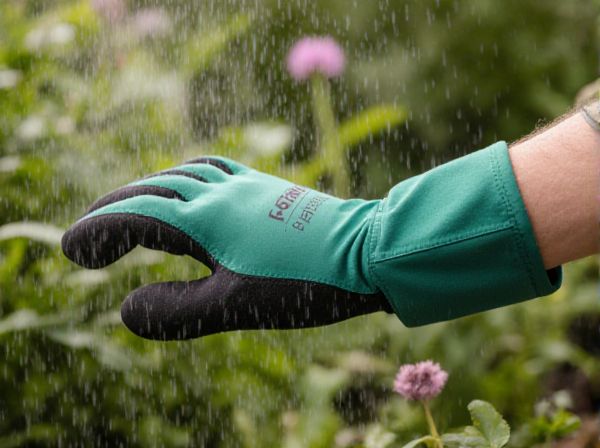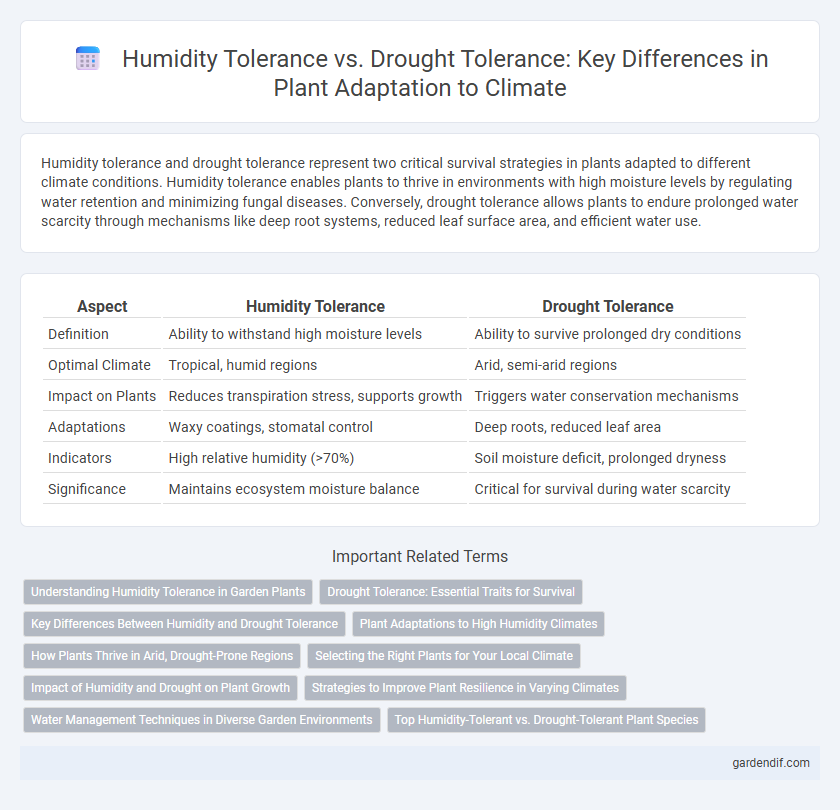
Humidity tolerance vs Drought tolerance Illustration
Humidity tolerance and drought tolerance represent two critical survival strategies in plants adapted to different climate conditions. Humidity tolerance enables plants to thrive in environments with high moisture levels by regulating water retention and minimizing fungal diseases. Conversely, drought tolerance allows plants to endure prolonged water scarcity through mechanisms like deep root systems, reduced leaf surface area, and efficient water use.
Table of Comparison
| Aspect | Humidity Tolerance | Drought Tolerance |
|---|---|---|
| Definition | Ability to withstand high moisture levels | Ability to survive prolonged dry conditions |
| Optimal Climate | Tropical, humid regions | Arid, semi-arid regions |
| Impact on Plants | Reduces transpiration stress, supports growth | Triggers water conservation mechanisms |
| Adaptations | Waxy coatings, stomatal control | Deep roots, reduced leaf area |
| Indicators | High relative humidity (>70%) | Soil moisture deficit, prolonged dryness |
| Significance | Maintains ecosystem moisture balance | Critical for survival during water scarcity |
Understanding Humidity Tolerance in Garden Plants
Humidity tolerance in garden plants refers to their ability to thrive in environments with varying moisture levels in the air, influencing transpiration and water uptake. Plants with high humidity tolerance often have adaptations like waxy leaves or stomatal regulation to prevent excess water loss and fungal diseases. Understanding these mechanisms helps gardeners select species suited for humid climates, ensuring optimal growth and resilience against humidity-related stress.
Drought Tolerance: Essential Traits for Survival
Drought tolerance encompasses the ability of plants to survive prolonged water scarcity through physiological adaptations such as deep root systems, reduced stomatal conductance, and osmotic adjustment. These traits enable plants to maintain cellular function and photosynthesis despite limited soil moisture. Understanding drought tolerance is critical for agriculture and ecosystem management in arid and semi-arid climates facing increased frequency of drought events.
Key Differences Between Humidity and Drought Tolerance
Humidity tolerance refers to a plant's ability to thrive in environments with high moisture levels in the air, whereas drought tolerance indicates resilience in conditions with limited water availability. Key differences include physiological adaptations such as stomatal regulation for drought tolerance to reduce water loss, while humidity-tolerant plants often possess mechanisms to prevent fungal infections due to excess moisture. Understanding these distinctions aids in selecting suitable species for specific climatic conditions and improving agricultural practices under changing environmental stresses.
Plant Adaptations to High Humidity Climates
Plants adapted to high humidity climates exhibit traits such as large, broad leaves with drip tips to shed excess water and prevent fungal growth. They often have thin cuticles and fewer stomata to facilitate gas exchange while minimizing water loss in consistently moist environments. These adaptations contrast with drought-tolerant plants, which develop thick cuticles, deep root systems, and reduced leaf surface area to conserve water during prolonged dry periods.
How Plants Thrive in Arid, Drought-Prone Regions
Plants thriving in arid, drought-prone regions exhibit high drought tolerance by developing deep root systems and storing water in tissues, enabling survival during prolonged dry periods. Humidity tolerance is minimal in these environments, as low atmospheric moisture drives adaptations like reduced leaf surface area and waxy coatings to minimize water loss. Species such as cacti and succulents exemplify these traits, optimizing water efficiency to withstand extreme drought stress.
Selecting the Right Plants for Your Local Climate
Selecting plants with high humidity tolerance is essential for regions prone to consistent moisture and heavy rainfall, ensuring they thrive without disease stress. Conversely, drought-tolerant plants have adaptations such as deep root systems and reduced leaf surface area, making them ideal for arid climates with infrequent precipitation. Matching plant species to the specific humidity and drought conditions of your local climate promotes sustainable gardening and reduces the need for supplemental irrigation.
Impact of Humidity and Drought on Plant Growth
Humidity tolerance enables plants to maintain cellular function and gas exchange in high moisture environments, reducing risks of fungal infections and physiological stress. Drought tolerance involves adaptive mechanisms such as deep root systems and osmotic adjustment to conserve water and sustain metabolic activities under limited water availability. Both tolerance types critically influence plant growth by affecting photosynthesis rates, nutrient uptake, and overall resilience to climatic stressors.
Strategies to Improve Plant Resilience in Varying Climates
Plants with high humidity tolerance employ physiological adaptations such as stomatal regulation and enhanced transpiration control to thrive in moisture-rich environments. Drought-tolerant species develop deep root systems and accumulate osmoprotectants to withstand prolonged water scarcity. Integrating genetic traits from both tolerance types through selective breeding enhances crop resilience across diverse climatic conditions.
Water Management Techniques in Diverse Garden Environments
Plants with high humidity tolerance thrive in moist environments, relying on water management techniques like mulching and drip irrigation to maintain consistent soil moisture. Conversely, drought-tolerant species adapt to arid conditions by utilizing water-saving strategies such as deep rooting and xeriscaping to minimize water loss. Effective garden water management integrates these approaches, optimizing irrigation schedules and soil amendments to support plant health across diverse climate conditions.
Top Humidity-Tolerant vs. Drought-Tolerant Plant Species
Top humidity-tolerant plant species such as ferns (Nephrolepis exaltata), mosses (Sphagnum spp.), and tropical orchids (Phalaenopsis spp.) thrive in consistently moist environments and can withstand prolonged high humidity levels. In contrast, drought-tolerant plants like cacti (Opuntia spp.), succulents (Agave spp.), and desert shrubs (Larrea tridentata) possess adaptations such as deep root systems and water storage tissues that enable survival under prolonged water scarcity. Understanding the physiological and structural differences between these species is critical for selecting suitable plants in varying climatic zones and for sustainable landscaping in response to climate change.
Humidity tolerance vs Drought tolerance Infographic

 gardendif.com
gardendif.com